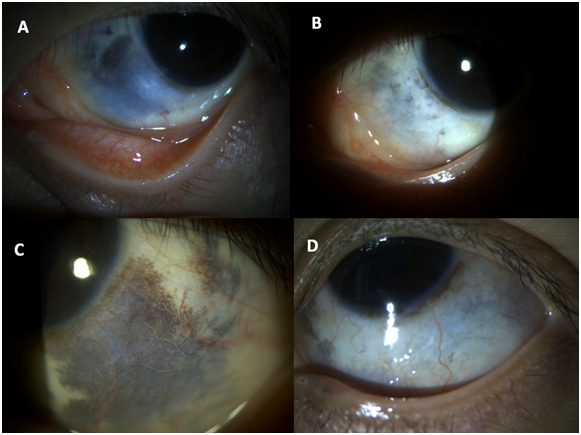
While Nevus of Ota is a concept foreign to many, most know what a birthmark is, which is what nevus of Ota essentially is. Scleral nevus of Ota is one manifestation of this condition in the eye and it has a noticeable effect on how a person looks. Recently, PUMCH pioneered in China a new CO2 laser-assisted removal technique for scleral nevus of Ota. This technique not only effectively removes scleral pigmentation but also reduces surgical complications and improves procedural efficiency.
Though nevus of Ota can appear on both sides of the face, it typically affects just one side, particularly in areas innervated by the first and second branches of the trigeminal nerve - most commonly around the eye socket, temporal region, nose, forehead, and cheekbone. Two-thirds of patients show eye involvement at birth, primarily appearing as blue-grey pigmentation on the sclera. Some patients may also develop pigmented spots on their eyelid conjunctiva, and in rare cases, similar lesions can appear on the mouth and nasal mucosa. While scleral nevus of Ota does not significantly impact eye health, its noticeable effect on patients’ appearance often puts them under considerable psychological distress.
For skin nevus of Ota, there exist effective treatments such as frequency-doubled YAG laser that breaks down pigment cells and activates phagocytes to remove the pigment. For scleral nevus of Ota, however, there have been no treatment options in China, with limited options available internationally. Given patients’ burning desire for treatment, PUMCH's Department of Ophthalmology has pioneered a CO2 laser-assisted lamellar sclerectomy to treat this condition.
When Linlin (pseudonym) was born, her parents noticed dark pigmentation on the right side of her face and the white of her right eye. After she was diagnosed with nevus of Ota, her parents had her facial pigmentation removed at a hospital, but the doctors were unable to remove the pigmentation on her eye. That led to unwanted attention from others since her kindergarten days and made her increasingly introverted.
Recently, Linlin's parents learned that PUMCH's Department of Ophthalmology could treat "birthmarks" on the eyeball. They thus sought out Chief Physician Liu Xiaowei, Director of Ophthalmology. Dr. Liu, considering Linlin's extensive scleral pigmentation and young age, developed a safer, multi-stage surgical plan for her.
The first surgery lasted about half an hour. Linlin reported feeling only mild eye discomfort during the procedure with no significant pain. The day after surgery, examination showed that most of the pigmentation on the white of her right eye had disappeared. After a week, her stitches were removed, and following a three-month recovery period, she'll be ready for the next procedure.
Dr. Liu explains that the surgery works by removing a layer of heavily pigmented superficial sclera to expose the deeper, less pigmented layer, which minimizes the effect of the pigmentation on appearance. Meanwhile, the CO2 laser is used to cauterize the pigmented sclera, ensuring effective hemostasis and surgical safety. The ophthalmology team has performed the surgery on up to 100 cases. Its efficacy and safety have been well-proven.

▲Pre-surgery and post-surgery comparison: Picture A and C show extensive pigmentation before surgery; Picture B and D show significant pigment reduction in the surgical area post-surgery, though final outcomes depend on how pigmented the deeper layer is
Important Note
If you're troubled by scleral nevus of Ota, you can schedule appointments with Chief Physician Liu Xiaowei or Attending Physician Gan Linyang.
How to Make an Appointment:
Download the PUMCH App → Click "Appointments" → Select "Dongdan Campus Regular Outpatient Care" → Choose "Ophthalmology" and make an appointment with the doctor you choose.
Written by Gan Linyang and Wang Jingxia
Reviewed by Yu Weihong
Pictures courtesy of the Department of Ophthalmology
Edited by Chen Xiao and Wang Jingxia
